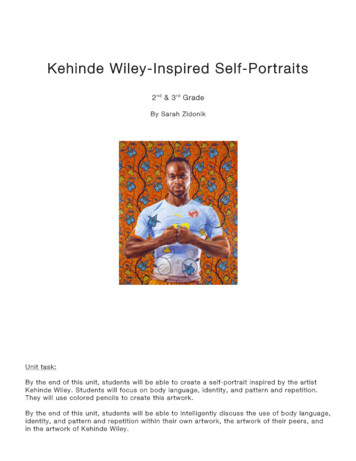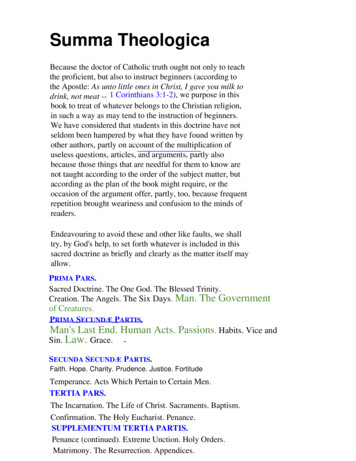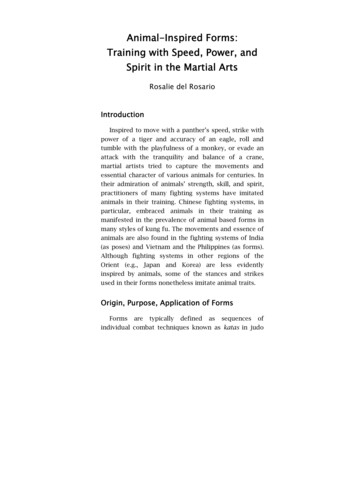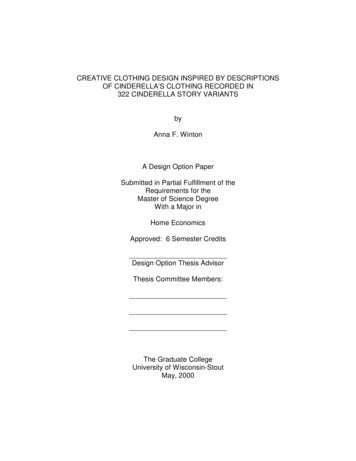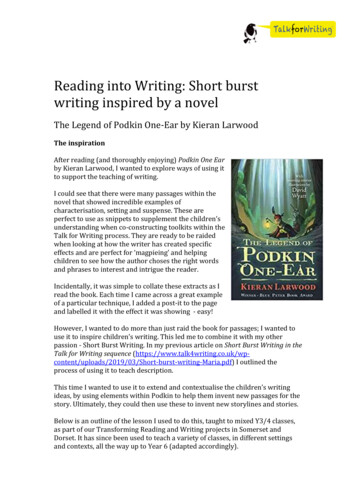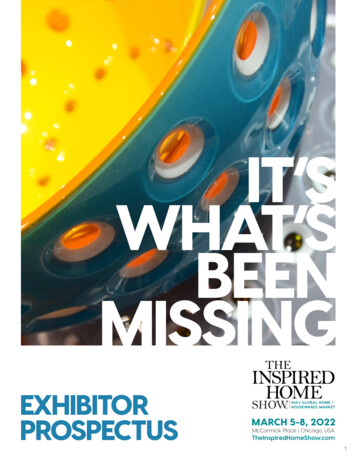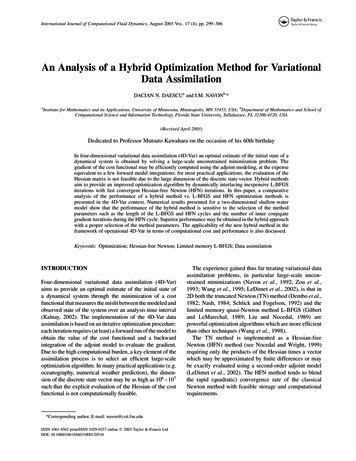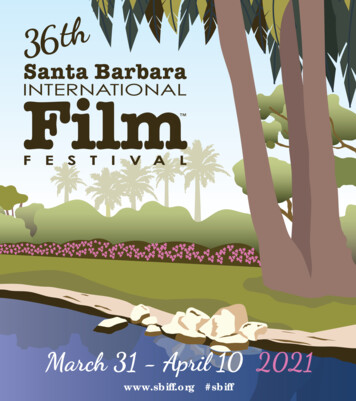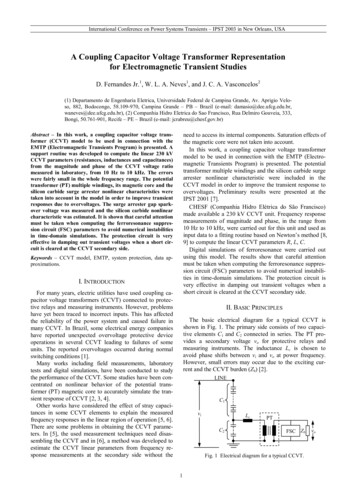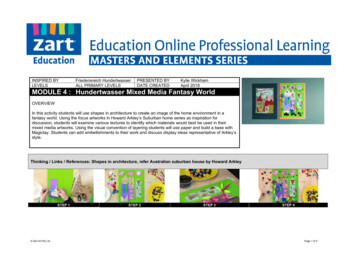
Transcription
INSPIRED BYLEVELSFriedensreich HundertwasserALL PRIMARY LEVELSPRESENTED BYDATE CREATEDKylie WickhamApril 2018MODULE 4 : Hundertwasser Mixed Media Fantasy WorldOVERVIEWIn this activity students will use shapes in architecture to create an image of the home environment in afantasy world. Using the focus artworks in Howard Arkley’s Suburban home series as inspiration fordiscussion, students will examine various textures to identify which materials would best be used in theirmixed media artworks. Using the visual convention of layering students will use paper and build a base withMagiclay. Students can add embellishments to their work and discuss display ideas representative of Arkley’sstyle.Thinking / Links / References: Shapes in architecture, refer Australian suburban house by Howard ArkleySTEP 1 Zart Art Pty LtdSTEP 2STEP 3STEP 4Page 1 of 5
Zart DREAMER StepsResources,MaterialsandIT ant Lesson PlanDiscuss &Research/ExperimentArt MakingExhibitResponseVictorian Curriculum StrandsExplore &ExpressVisual ArtsPracticesPresent &PerformRespond& InterpretMODULE 4: Shape Colour TextureDiscus some of the images of Hundertwasser which relate to small buildingsand family homes.Observe the textures. What materials might give a similar “look” to the artists’images?Define what materials could make flowers, raindrops, trees or letterboxes?EQUIPMENT Assorted corrugated cardAssorted decorative papersMagiclayStackable jewelsStackable sequinsGlitter pom pomsButtonsChenille Stems & BumpsPatty PansGluesticksSupertacPaper Crimper 11cmCover paper assorted 380 x510mm ScissorsPROCESSPart 1STEP 1 – Cut shapes out of coloured/patterned corrugated card. Use theseshapes to create buildings and houses, and glue onto an A4 piece of colouredcorrugated card.STEP 2 – Layer buildings with different textured and coloured papers.Part 2STEP 3 – Using Magiclay as a base, add in chenille stems and jewels to createforegrounds of flowers, trees, raindrops, etc.STEP 4 – Embellish with sequins, pom poms, and patty pans.EXHIBITMount onto cover paper. Let students select the background colour.Discuss the best way to display, and whether it might include some ofHundertwasser’s works as well.Develop questions to ask students. For example;1.2.3.4. Zart Art Pty LtdHow was it made? (Material & process/what did you do?)What do you see? (Art language: art principles & elements)What does it mean? (Deeper/higher order thinking)Is it good/do you like it? Why? (Personal response)Page 2 of 5
Mapping to the Victorian CurriculumVisual Arts Strands:Explore & Express Ideas: Exploring, imagining, experimenting and expressing ideas,concepts, themes, values, beliefs, observations and experiences in artworks that studentsview and make.Present & Perform: Creating, exhibiting, discussing, analysing artworks and considering theintention of artists and curators. Considering the relationship between artist intentions andaudience engagement and interpretation.Visual Arts Practices: Developing understanding and skills by exploring, selecting, applyingand manipulating techniques, technologies and processes. Conceptualising, planning anddesigning artworks.Respond & Interpret: Analysing, evaluating, interpreting and reflecting upon meanings,beliefs and values in artworks. Examining artworks in historical and cultural contexts.The DREAMER Steps The step-by-step instructions in this document are offered to you – the teacher – as a guide, but if they are delivered word by word to your students, the outcome would be very uncreative. It is in this context that weintroduce to you the DREAMER Steps to teaching art. DREAMER stands for Discussion, Research, Experiment, Art Making, Exhibit and Response. DREAMER is our initiative to create a common language amongteachers in art education. We hope it will stand the test of time and we would like to encourage you to use it in your art making classes.The DREAMER Steps should be undertaken with thoughtfully directed questions, so that the teacher challenges thinking and harnesses creative outcomes from each individual. “Teacher talk” – or more precisely "teacherquestioning technique", plays a huge role in determining how students are encouraged to achieve their individual potential. Some activities are more challenging than others and so the teacher must know the students’ skilllevels and interests when choosing an activity to ensure teaching and learning is differentiated. Moreover, assessment should be ongoing throughout the learning experience, rather than just an evaluation of the finalartwork.DiscussionResearchExperimentArt MakingExhibitResponseDiscussion is the first DREAMERStep and it is initiated throughquestions that will encouragestudents to share their knowledgeof a particular story or theme inresponse to the artist’s artwork.Students share what they knowand raise questions about whatthey want to know. E.g., Whatmedia did the artist use? Whatdid the artist base the artwork on?This information will be used tocreate an artwork in response,along with the students' visualinterpretation of the artist’s work.At this step, students find outanswers to the questions theyhave asked. In the process ofresearch, students may delve intoother aspects of that topic.Students discover more about itand associated links that maytake them in a completelydifferent direction. They researchand collate information about theartist and artwork, through librarybooks, magazines and theInternet. Family and friends aresometimes a great resource togain knowledge from.Based on their research, studentsbuild up a record of elements thatmight be incorporated into theirown artworks.Art making can be a multimediaexploration and there aretechniques, skills and processesthat have to be learned, such as,colour mixing, joining techniquesof different media, printmaking,collage and construction, toachieve the desired results. Allowstudents time to experiment witha variety of media that arerelevant to the artist’s artwork.The steps taken prior to ArtMaking will allow the students tomake informed decisions abouttheir artwork and provide themwith the confidence to create aunique work of art. They mustremember to respect the work ofthe artist, but the desired effectand the overall impression are intheir hands. A technique, mediaand/or element is chosen.Students will present their owninterpretations of what they seeand know, and they will use theirskills to convey this in their ownwork.Exhibiting the artworks may takeon a whole new meaning if theresults of discussion, researchand media experimentation areincluded. Visual Journals mayrecord their findings and beworthy of viewing alongside thefinished artwork. Some thoughtneeds to be given to theexhibition space and the type ofaudience anticipated, forexample, can the exhibitionspace be enhanced with drapedfabric or boxes of varying heightson which to place any threedimensional work? Whatinformation does the audienceneed to know? Should the artist’sartwork, that the work is basedon, be included in the display?Should acknowledgements bemade of the artist?Response to the student artworkshould take on some form of selfassessment. The process shouldbe discussed and throughexchange of ideas and opinions,students may learn from theirpeers. Students might sendimages of their artwork to theartist or a gallery. Zart Art Pty LtdPage 3 of 5
Zart School Customer Order FormThis order must be accompanied by an official school/organisation purchase order and signed by the appropriate person.Delivery Date required:Purchase order number:(Required to process this order)NameHOW TO USE THIS FORMTo help us process this order promptly please print neatly, with a black or blue pen only.Clearly identify the item, colour, size and quantity required.DepartmentYour Email AddressFax to: ( 61) 3 9898 6527Email to: orders@zartart.com.auAlternatively, visit our website for quick and convenient shopping.School/OrganisationDelivery AddressPhone NumberStatePostcodeTo help serve you better, what is the best time to contact you regarding this order?Minimum order value for all FAX, POST and EMAIL orders is 50.00 (ex GST);orders below this value will be charged a processing fee of 8.95 (ex GST).There is NO minimum order value charge on ONLINE orders.Do you want to PICK UP this order? If YES, please select location AND specify time/day:Customer Service Centre, Box Hill North:Yes / NoZart Warehouse, Noble Park North (Pick ups only, shopping not available):Yes / NoFreight charges apply to all orders, please refer to our latest catalogue or visitwww.zartart.com.au for details.Pick Up B206AA280SC013PP205SM008CH054PA013ML300PRODUCT NAME & DESCRIPTIONPaper Magiclay 240g Coloured ‐ CanisterJewels Asst 750's StackableCover Paper 125gsm 38 x 51cm AsstSequins Asst 100g StackableSupertac Glue 550mlMetallic Board D/S Gold/Silver A4 12’sCorrugated Natural Card A4 20’sCorrugated Construction Strip 60’sZart Glue Stick 35gBasics Zart Scissors 170mmBasics Pom Poms Glitter Asst 200'sBasics Buttons Asst 600g approx 1400pcsBasics Chenille Stems & Bumps 30cm 200'sMini Patty Pan 1000's AsstPaper Magiclay 240g Coloured ‐ CanisterQTYSignature:Fax to: 03 9898 6527 Zart Art Pty LtdUNIT PRICETOTALTOTALShop Online at www.zartart.com.auPage 4 of 5
Zart Art Pty LtdPage 5 of 5
Discuss the best way to display, and whether it might include some of Hundertwasser’s works as well. Develop questions to ask students. For example; 1. . artist and artwork, through library books, magazines and the Internet. Family and frien
